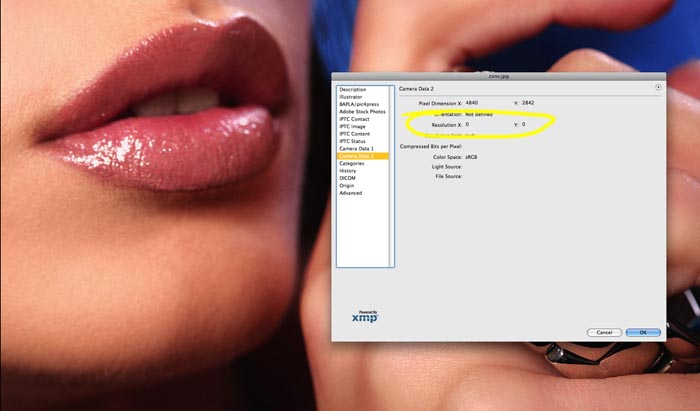Archive for September, 2008
High resolution
September 26th, 2008by Gwyn Headley
Managing Director
fotoLibra demands that all images uploaded to the site have a resolution of 300 pixels per inch.
Now we all know that the resolution of an image is irrelevant and unimportant; whatever it is, it’s the same image. Absolutely right.
But when you look at an image Preview in fotoLibra, we show you the print dimensions of the image in inches and millimetres. That’s the reprographic size, printing in CMYK.
We use a sum to show you this, dividing the given pixel dimensions by 300. If the image is 72 ppi or 2400 ppi, the result of the sum will be wrong. And buyers (who all want 300 ppi) will get confused.
When TIFFs are uploaded to the site, we convert them to 300 ppi automatically. We can’t do the same for JPEGs because the process would involve resaving the image, and as a JPEG loses quality the more often it’s saved, we need to avoid that.
One or two members have had their uploads rejected because the image had a resolution of 0 ppi. We thought that was tough even by fotoLibra’s notoriously rigid standards, and asked to see the images. So in they came and they both returned a res of 72 ppi.
It’s Photoshop. It doesn’t always agree with what the camera thinks it’s done. Here are three examples of the same open and untouched photograph, simply showing the different metadata Photoshop displays about the image.
Here you can clearly see in the EXIF data that the image has a resolution of 0ppi. They are lying to you.

This is the standard window for Photoshop to display the image’s resolution. It’s 72 ppi.

And here Photoshop is showing us the camera data. Well, well, well, it’s 300 ppi.

So what is right and which is right and what is right for you and fotoLibra?
Well, upload TIFFs and the problem disappears.
Strip the EXIF data from the image and the problem disappears.
Accept a ragbag of resolutions and the problem disappears — but so do the clients.
Martin Evening in his impressive work ‘Adobe Photoshop CS3 for Photographers’ writes “There is a common misconception in the design industry that everything must be supplied at 300 ppi. This crops up all the time when you are contacting clients to ask what resolution you should supply your image files at. Somehow the idea has got around the industry that everything from a picture in a newspaper to a 48-sheet poster must be reproduced from a 300 ppi file. It does not always hurt to supply your files at a higher resolution than is necessary, but it can get quite ridiculous when you are asked to supply a 370 MB file in order to produce a 30″x36″ print!”
In ‘Real World Photoshop CS3’ the perennially readable David Blatner notes “The key to making resolution work for you is knowing how many pixels you need for an image’s intended output.”
fotoLibra believes in supplying what the client wants from the outset. If they want 300 ppi, they shall have 300 ppi. And we don’t accept files over 100 MB anyway!
Nice one
September 24th, 2008by Gwyn Headley
Managing Director
There’s a fascinating photo blog called Photopreneur, clearly about making money from photographs, and they’ve just run a really good article on fotoLibra.
It’s pretty accurate as well, apart from me saying we’d only rejected four images in the whole time since we started, but when I pointed this out to the writer, it was corrected the next time I looked. Pretty impressive.
How do we go about getting more articles like that? Journalists always say they want to write about something new, different and exciting, but when they get round to filing their articles it’s the same old diet of Google, Flickr and Facebook.
Any suggestions? Or are any journalismos reading this? I’m happy to talk!
Cheerio Neil!
September 23rd, 2008by Gwyn Headley
Managing Director
Next to me, Yvonne, Llinos and of course Jacqui, Neil has been our longest serving staffer. So it was sad to see him stride off to exciting new challenges last Friday. He’s been with us for nearly three years, joining us part time while he was still at Uni, then coming on board as soon as he graduated.
We’ve been lucky to have him. He’s highly intelligent and competent, he swims in the Ocean of Common Sense every day, and he was damn good at his job. We didn’t want to lose him, but you can’t argue with a 300% salary hike.
Mind you, everyone in his new Soho-based office is allegedly bald; whether by choice or design we can’t say. It’s probably stress. We find the office cat does much to relieve the load.

Bodoni using Neil’s desk as a motorway
Hang about — he told me he was a dog lover. Maybe that’s why he left?
Anyway Damien, our new Technical Development Manager, is settling in well. Thanks to him, fotoLibra members and buyers can now riffle through collections and lightboxes of image previews with speed and ease.
And the cat loves him.
Adobe CS4 Pricing
September 23rd, 2008by Gwyn Headley
Managing Director
Software giant Adobe has just announced Creative Suite 4, upgrades to Photoshop, Dreamweaver, InDesign, Flash, Ilustrator etc. It’s a phenomenally complex and capable package, and for a digital online picture library like fotoLibra it’s as crucial as a power supply.
The upgrade costs $599, so cynically I expected the British version to be priced at £599.
Oops — I was wrong. The British version sells for £605.
$599 at today’s exchange rate is £323.50. Take away the VAT and the British version (excluding tax) is priced at £515.
That is 63% more expensive than the US upgrade.
So we in Britain pay £191.50 more for exactly the same product. That’s $354.60.
Why are you ripping us off, Adobe? I cannot think of a single justifiable reason other than corporate greed and the cynical exploitation of a captive market. I think I’d admire the company more if it simply admitted “Because we can,” but it will hide behind mealy-mouthed clouded obfuscations of market penetration and market forces.
Bollocks.
Why is there only one Monopolies Commission?
Interesting times
September 16th, 2008by Gwyn Headley
Managing Director
Lehman Brothers collapses.
Corbis lays off 175 jobs.
Photoshelter closes its Collection, a fotoLibra copy which launched itself in September 2007 by grandly announcing itself as The First Online Marketplace To Provide Professional and Amateur Photographers An Opportunity to Sell Their Images to Commercial Buyers. Not remotely true, but more on that later.
A comment by MarcW on the Photopreneur blog hit the nail on the head — Photoshelter made the mistake of believing what buyers told them. Buyers always demand new, exciting, cutting edge work, but they buy conventional and they buy safe. Pollsters for any forthcoming election in Photoshelter’s home country should bear this in mind; there’s even a term for it when it happens in a racial context: The Bradley Effect.
It’s little to do with race, it’s the person being polled who wants to appear smart / cool / savvy / unprejudiced / avantgarde in the eyes of another human being, the pollster. So of course buyers are going to be seen and heard asking for images on the edge. It’s true, they love to look at them, but that’s not what they have to buy. Don’t poll the picture buyers, ask the shareholders in the companies they work for.
Several Photoshelter photographers have approached us to ask if they can transfer their images to fotoLibra. We welcome them with open arms and we’ve contacted Photoshelter to ask how we can facilitate the move, but there hasn’t been any response from them as yet. That’s understandable, I suppose; I sympathise and commiserate with Photoshelter’s staff who must be hurting a lot at the moment. If any Photoshelter members read this, perhaps you could ask them about transfers as well?
Any diminution in the picture sales business lessens us as well, because we are part of it, but Photoshelter’s claim is patently untrue, as fotoLibra was doing this in beta as far back as April 2004 and has been doing it increasingly successfully since January 2005. fotoLibra was incontestably the first open access picture library, The First Online Marketplace To Provide Professional and Amateur Photographers An Opportunity to Sell Their Images to Commercial Buyers, but We Didn’t Use Quite As Many Capital Letters. We now have 19,000+ members in 150 countries.
But hubris (and shaky research) meant Photoshelter could make false claims like this — we don’t have time to contest them because we’re too busy selling pictures, which I guess may have contributed to Photoshelter’s downfall. Those cows don’t milk themselves, you have to go out and greet them, on behalf of all your photographers.
Duty and responsibility, I guess.
40 Miles Of Bad Seas
September 12th, 2008by Gwyn Headley
Managing Director
It was a bad day for the picture library business yesterday, or stock agencies as they’re erroneously called in the US. Bill Gates’s perpetually loss-making Corbis slashed 175 jobs, and PhotoShelter is closing its stock agency department PhotoShelter Collection next month. The blame is placed variously on the credit crunch, Getty Images, microstock, bad moon rising, cost of oil, what have you.
We’ve already been approached by some PhotoShelter contributors to see if we can offer a safe harbour for their image collections.
Big ships struggle and sometimes founder in stormy seas. Sprats like fotoLibra certainly get tossed around but usually carry on swimming. We have signed supplier contracts with most major UK book publishers this year, and at next month’s Frankfurt Book Fair we have 51 meetings already lined up. We haven’t got two pennies to rub together, but we’re supplying a great service to our clients and our member photographers are making money from our work.
And one day so will we.
What some businesses have to put up with
September 11th, 2008by Gwyn Headley
Managing Director
I had a meeting with a large publisher yesterday.
They get over 30 letters a month from people saying “You’ve used my picture in one of your books, pay me.”
Every letter has to be answered. The publisher asks for a photograph of the complainant. It takes about an hour to check the image, check the model releases for the book, write a reply — it ties up the legal department whose time could be better spent signing contracts with fotoLibra. Not one person has pursued their claim further.
So the publisher quite rightly has demanded model releases for all images of people that they use. Shots taken in classrooms can have the signature of the school principal, not every individual in the image. It’s impossible to get model releases for everyone in a crowd shot, so chances do have to be taken.
The same publisher has been awarded contracts to publish educational schoolbooks for a large Eastern European country, on condition the books are printed in that country. So the printing goes ahead, the rep visits the schools with the brand new books and is unblushingly informed that the school doesn’t want to buy the books because they already have them, at half the price the legit company is selling them for.
The books are shown and they are identical, except for the cheaper paper and binding. What happens is that the disc sent to the printer is immediately copied, the books printed elsewhere and rushed out to the schools. Lots of shoulder shrugging and expressions of regret, massive loss for the publisher. It’s a wonder they carry on.
It’s not simply the sneaky Slavs — the same thing happened with a long-standing EU member country whose Prime Minister owned several printing companies.
Bizarre, isn’t it?

